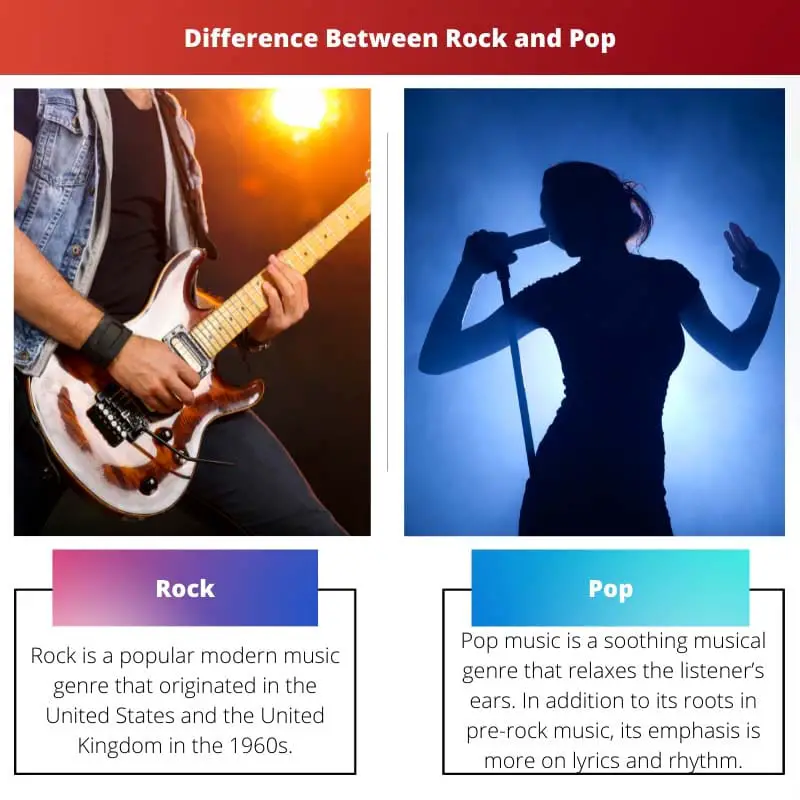There are many different types of music that we all appreciate. All the genres of music either fall under soft genres or loud genres. People like listening to various forms of music depending on their personal preferences.
Pop and rock music are popular with young people, especially in Western countries such as America, Brazil, Mexico, and the United Kingdom.
Key Takeaways
- Rock music emphasizes strong rhythms, guitar-driven sound, and powerful lyrics.
- Pop music focuses on catchy melodies, simple arrangements, and wide appeal to a mainstream audience.
- Both are popular music genres, but rock tends to be more instrumentally and lyrically complex than pop.
Rock vs Pop
Rock is characterized by electric guitars, bass guitars, drums, and strong vocals and is considered to be louder and more aggressive than pop music. Pop is characterized by its catchy melodies, more danceable and upbeat rhythms, featuring electronic instruments.

Rock is a popular modern music genre that originated in the United States and the United Kingdom in the 1960s. It is a type of music aggressively played on various musical instruments.
Furthermore, it can take many other forms, like jazz-rock, punk, country, and classical rock.
Pop music is a soothing musical genre that relaxes the listener’s ears. In addition to its roots in pre-rock music, its emphasis is more on lyrics and rhythm.
It has better lyrics and is easier for the viewers to understand because of the clarity in the music notes. It can be performed without many musical instruments and on any subject.
Comparison Table
| Parameters of Comparison | Rock | Pop |
|---|---|---|
| Invented by | The rock genre was created in the 1960s. | Thomas Edison and Emile Berliner discovered pop music. |
| Invented in | Another name for rock music is rock and roll. | The pop genre was invented in the 1940s. |
| Common Method | It is played on loud sounds of instruments. | It is sung on gentle beats. |
| Another Name | Another name for pop music is popular music. | Rock music is played for a more extended period. |
| Length of the music | Rock music is played for a longer period. | Pop is played for a shorter period comparatively. |
What is Rock?
The name rock genre is derived from the phrase rock and roll (popular dance music in Western countries (America and England) around the mid-nineteenth century) in the 1960s.
The American lyrics writer and singer Chuck Berry composed the first-ever rock music.
Rock music is based on the concept of African American genres (blues and R&B). During the 1960s decade, the limitation of the music was tested when rock music was new for music lovers.
Many dance genres were also introduced at this time, in addition to rock music.
Rock music became popular during black-and-white, and everyone danced to its beats. It is regarded as a modern music genre that is loud and played in groups accompanied by electric guitars (three cords) and drums at high volume.
The group playing rock music was known as rock bands.
In other words, we can say that this type of music is energetic and make everyone dance along with high energy.
With the developing craze of rock music, lyrics writers started writing rock songs on distinct themes such as love, party, youth, political and social issues.
There were many subgenres of rock music in the early 1970s: glam rock (performers wore flashy clothes with glittery footwear) and punk rock (when rock bands appeared in fashionable outfits).

What is Pop?
Pop is an acronym for popular music which came in the 1940s, two-decade before rock music in America and the United Kingdom. Initially, songs were vocal, and most of the instruments used were saxophones.
All the pop songs (White Christmas, The paper doll, Swinging on the Star) in the 1940s had a sweet melody and were most vocal. After the 1955s, pop music sung by groups of Bill Haley and Elvis Presley was energetic.
Various props and instruments were used in the performance at that time.
Multiple trends largely influence pop music. Furthermore, this music, like rock music, was popular in 1960. It explored other musical instruments to create pop music and incorporate comparable genres.
After a decade, a funk-pop subgenre emerged, quickly becoming popular.
Funk pop was mainly played at parties as it had disco beats with clear sounds. The instrument played was an electric guitar. Michael Jackson made this genre more successful by releasing his albums.
In the late-twentieth century, pop music was played in advertisements as a part of the business.
Rap was later integrated into the pop genre in the new millennium to maintain its popularity. Moreover, Lady Gaga gave multiple hits on self-empowerment themes. The pop genre has revived its success worldwide.

Main Differences Between Rock and Pop
- Rock is a heavy genre of music as compared to the pop genre.
- The subgenres of rock are punk rock and glam rock. On the other hand, funk-pop and disco-pop are subgenres of pop.
- The rock genre was never played in commercials to sustain popularity. However, the pop genre played a considerable role in promoting the product in advertisements.
- Rock is linked with the genre of rock and roll. On the contrary, pop means the popular genre of music.
- Rock music is played in groups known as bands. On the other hand, pop music can sometimes be played solo with vocals or in a group with musical instruments.

- https://asa.scitation.org/doi/abs/10.1121/1.3263611
- https://books.google.com/books?hl=en&lr=&id=laQjEAAAQBAJ&oi=fnd&pg=PR7&dq=rock+and+pop&ots=dq1etKrY4A&sig=TPGgCnvw9ZnCwJhUzsmaMomfHPE

While the article serves as a good introductory piece to those unfamiliar with such musical genres, I find that its generalizations may oversimplify the complexities of these musical forms.
I appreciate the inclusive approach of the article, encompassing a broad historical and stylistic scope of rock and pop music. However, a more critical analysis could enhance the overall depth of the discussion.
The article offers a concise yet comprehensive overview of the fundamental differences between rock and pop music, and clearly highlights the distinguishing characteristics of the two genres.
I completely agree. It efficiently captures the essence of rock and pop music, shedding light on their historical origins and their evolution over time.
The comparison of rock and pop music is insightful. Its clear exposition of the historical and musical distinctions between the two genres provides a valuable reference for scholars and enthusiasts alike.
This informative piece lays a solid foundation for exploring the intricacies and divergences between rock and pop music, yet it could further emphasize the fluidity and interconnectivity of musical genres in the context of cultural evolution.
The historical context indeed adds an enriching dimension to the article, contributing to a comprehensive understanding of the evolution of rock and pop music.
The piece does a commendable job of providing an in-depth discussion of rock and pop music, but it would benefit from an exploration of the cultural and social influences that have shaped these genres over time.
The comparison table is particularly enlightening, giving a clear breakdown of the distinctions between rock and pop music. However, I believe the historical context could benefit from further elaboration.